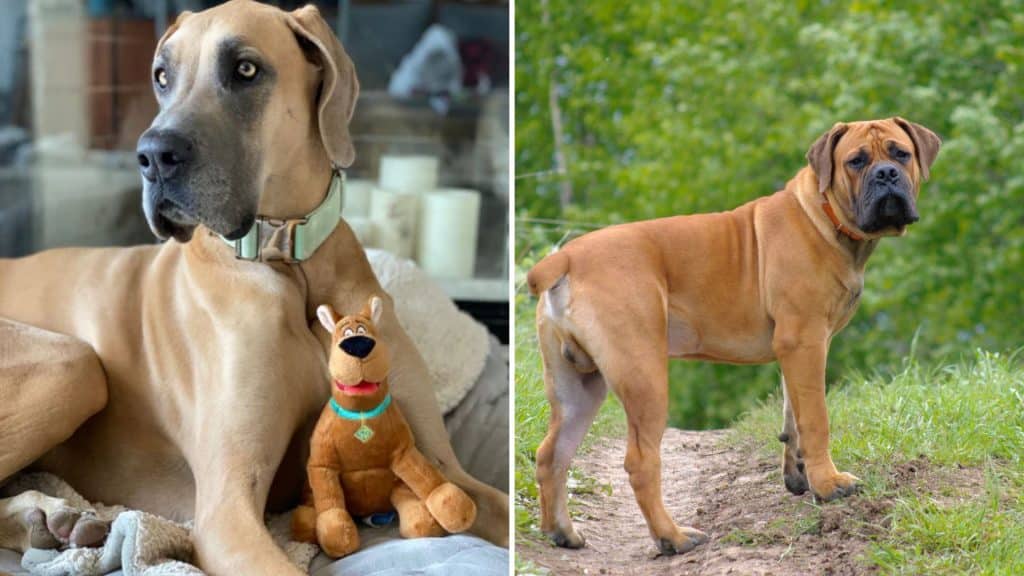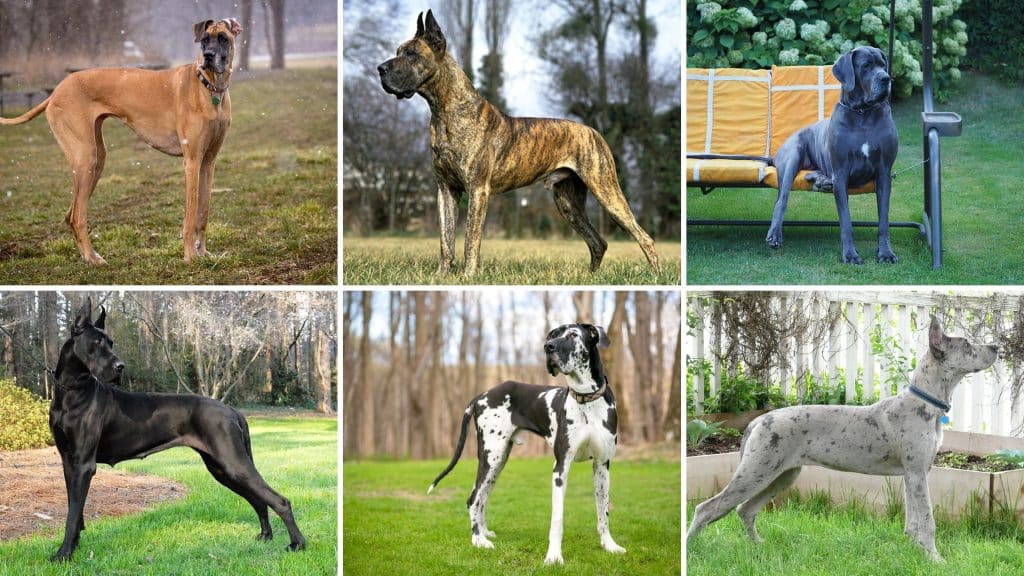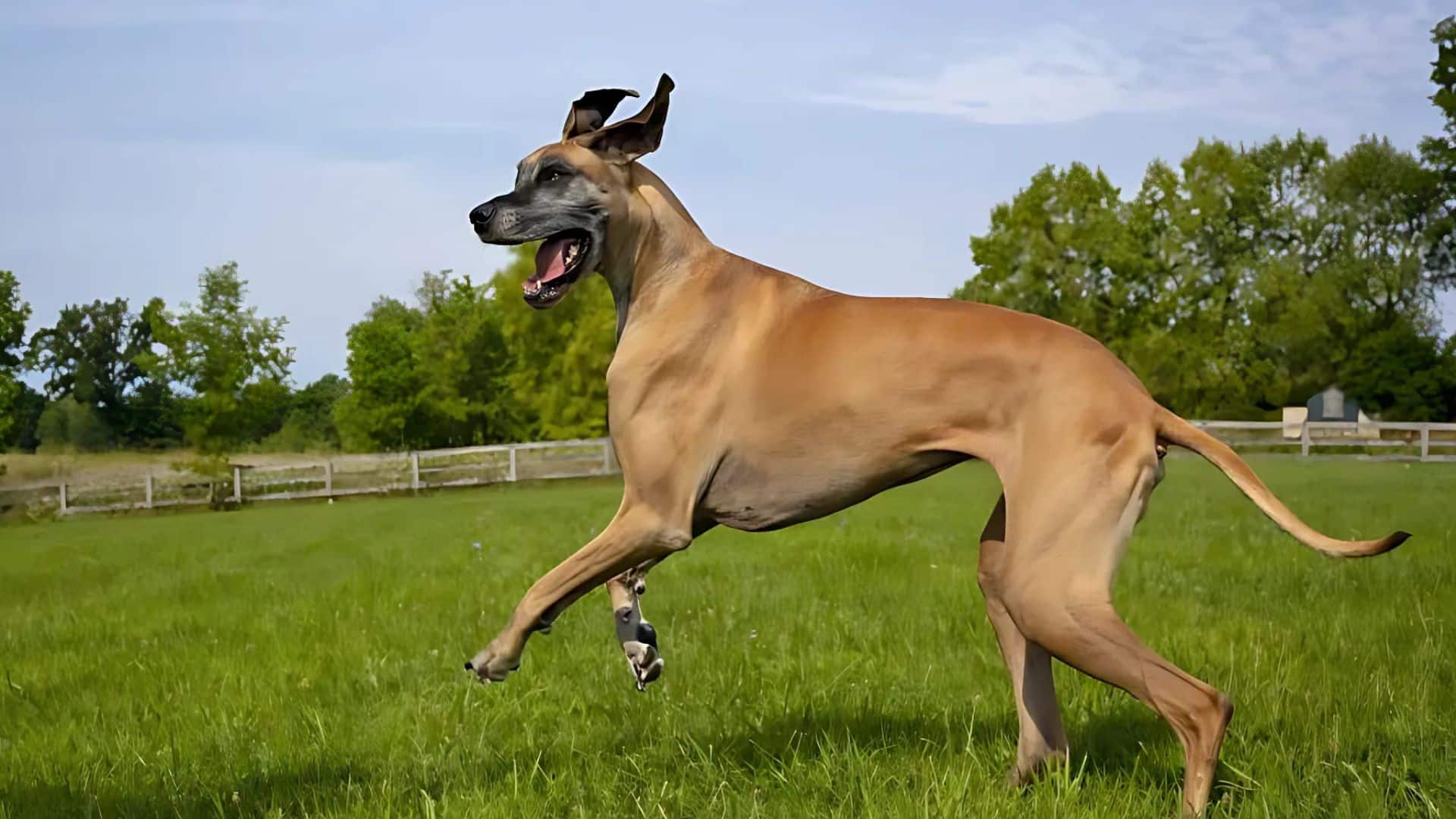Have you ever wondered if your gentle giant Great Dane shares ancestry with the powerful Mastiff breeds?
This question puzzles many dog owners, especially those examining big dogs that start with d like Dobermans, Dalmatians, and these towering breeds.
Despite their similar commanding presence, Great Danes and Mastiffs come from entirely different lineages.
Though similar in size, their body structures reflect unique functions, speed versus stability.
Great Danes were selectively bred for agility and endurance, while Mastiffs were prized for their courage and loyalty.
This guide clears up the confusion between these magnificent breeds. We’ll examine their origins, classifications, and unique characteristics.
Knowing these differences makes it easier to pick the gentle giant that suits your family best.
Are Great Danes Mastiffs?
No, Great Danes are not Mastiffs. Though each breed is impressive and robust, their official classifications place them in separate corners of canine history.
Here’s why this confusion happens. Both breeds are massive dogs that can easily weigh over 100 pounds. When you see them side by side, they both look imposing and powerful.
But what you need to know about their actual classifications is:
If you’re looking at a Great Dane, expect a graceful, athletic dog bred in Germany for challenging pursuits. These dogs have taller, athletic builds designed for speed. They fall under the Working Group but serve a hunting purpose.
If you’re looking at a Mastiff, expect a dog steeped in tradition as a loyal home and estate sentinel. These dogs have bulkier, muscular frames built for raw strength. They’re also Working Group dogs but with deep protective instincts.
Think of it this way, like Great Danes were the athletes of the dog world, while Mastiffs were the bodyguards. Both are Working Group breeds according to the AKC, but they were developed for completely different jobs.
History of Great Danes and Mastiffs

Knowing the history of these two breeds explains why they developed such different characteristics despite their similar size.
Origin of Great Danes
Great Danes originated in Germany, not Denmark, despite their name. German nobles bred them in the 16th century for hunting wild boar.
The breed developed from crossing English Mastiffs with Irish Wolfhounds. This combination created a dog with the Mastiff’s strength and the Wolfhound’s speed and agility.
German breeders needed dogs capable of taking down 400-pound wild boar with deadly tusks.
By the 1700s, Great Danes became luxury symbols among European royalty. German princes kept elaborate packs that wore golden collars.
Timeline of Great Dane Development:
- 16th Century: German nobles begin selective breeding programs.
- 1700s: Breed becomes popular among the European aristocracy as a status symbol.
- 1876: First Great Dane registered with the German Kennel Club officially.
- 1887: The Great Dane Club of America was established with breed standards.
Mastiff Heritage
English Mastiffs have a much older history dating back over 2,000 years. Ancient civilizations used them as war dogs and guardians.
Roman armies employed Mastiffs in battle alongside soldiers. British tribes also used these powerful dogs to defend their territories against invaders.
Key Difference: While Great Danes were refined hunters, Mastiffs served as battlefield warriors and estate protectors throughout their development history.
Types of Great Danes

The American Kennel Club recognizes six official color varieties of Great Danes. Each type has the same temperament and build but different coat patterns.
Recognized Color Varieties
Fawn: Light yellow to deep golden color with a black mask on the face. This is one of the most common and popular Great Dane colors.
Brindle: Fawn base color with dark tiger-like stripes throughout the coat. The stripes should be clearly defined and evenly distributed.
Blue: Steel blue color that appears gray-blue in sunlight. This color results from a dilution gene and is highly sought after.
Black: Solid black coat with possible small white markings on chest and toes. The black should be deep and glossy.
Harlequin: Pure white base with irregular black patches scattered across the body. This striking pattern is one of the most recognizable.
Mantle: Black and white pattern similar to a Boston Terrier. Black covers the body with white on the chest, neck, legs, and face.
Size Standards Across All Types:
- Males: 30-32 inches tall, 140-175 pounds
- Females: 28-30 inches tall, 110-140 pounds
Traits of Great Danes vs Mastiffs
Knowing the key differences between these breeds helps you choose the right companion. Each breed offers unique characteristics that suit different family lifestyles and living situations.
| Feature | Great Dane | Mastiff |
|---|---|---|
| Height | 28-32 inches | 27-30 inches |
| Weight | 110-175 lbs | 120-230 lbs |
| Build | Graceful and streamlined | Solid and imposing with a weighty bone structure |
| Head Shape | Narrow and refined, rectangular | Broad and massive, square-shaped |
| Temperament | Gentle giants, social and friendly | Natural guardians, calm but protective |
| Energy Level | Moderate, needs daily exercise | Low to moderate, less active |
| With Children | Patient and playful | Protective but gentle |
| Guarding Instinct | Low, more welcoming to strangers | High, naturally suspicious |
| Training | Eager to please, responds well | Independent streak, can be stubborn |
| Exercise Needs | 30-60 minutes daily | 20-40 minutes daily |
| Living Space | Prefers larger homes with yards | Adapts to smaller spaces better |
| Grooming | Minimal, weekly brushing | Minimal, but sheds more heavily |
Key Takeaway: Great Danes are taller athletes, while Mastiffs are broader protectors, each suited for different family needs.
Final Thoughts
Great Danes and Mastiffs share impressive size but represent distinct breed types with unique characteristics.
Great Danes give the impression of elegant height, while Mastiffs display grounded, powerful proportions.
Both breeds make excellent family companions when properly trained and socialized. Great Danes suit active families who enjoy outdoor activities. Mastiffs work better for those seeking calmer, more protective companions.
Both breeds require significant commitment regarding space, food costs, and long-term care needs. Their loving personalities make them rewarding companions for the right families.
At their core, Great Danes embody elegance and energy, whereas Mastiffs symbolize strength and steadfast defense.
What questions do you have about Great Danes or Mastiffs? Share your thoughts about these magnificent breeds in the comments below.








